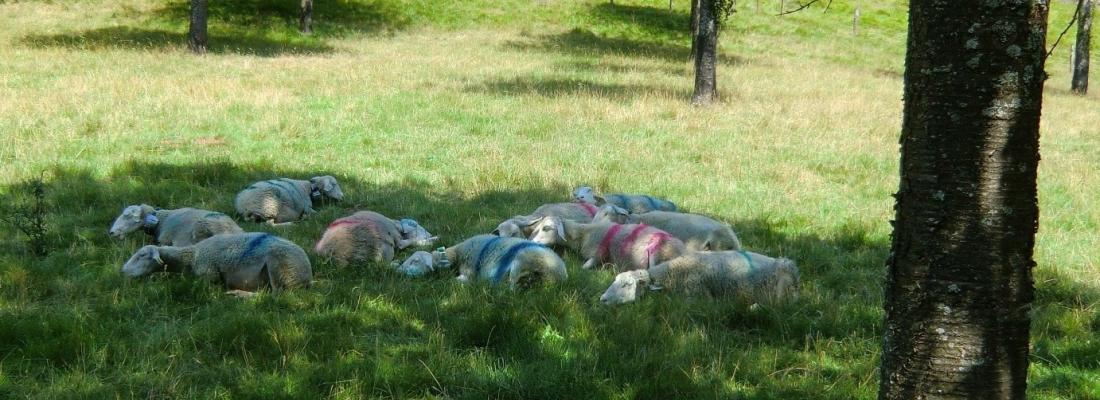Climate change and risks Reading time 6 min
Shade from trees: a beneficial refuge for the well-being of grazing animals
Published on 27 June 2025

Agroforestry systems can provide a number of services for livestock farming, particularly for systems that exploit grazing resources and are subject to climatic constraints. This study was conducted to assess the effects of trees and the shade they provide on the behaviour, well-being and performance of grazing ewes.
The study was carried out at the Herbipôle (63) and involved three permanent grasslands of 0.8 ha each, with either :
- 1 tree (representing 0.8% of the grassland surface) - Control (C),
- 60 trees/ha (40%) - Moderate density (D),
- 150 trees/ha (81%) - High density (D+).
For three consecutive years, each meadow was grazed continuously by ten Romane ewes and their two lambs (until weaning), in spring and summer.
The ewes' activity and position in relation to shade were recorded on a total of 12 sunny days (6 to 7.5 h/d) over the three years (May to August). On the same days, the ewes' respiration rates were recorded. The nearby INRAE Climatik weather station was used to characterise the climate during the observation days. The performance of the ewes and their lambs, as well as the biomass and quality of the available grass, were measured over the course of the grazing season.
Logically, ewes were more often observed in the shade in the grasslands with the most trees (44% of scans on C, 73% on D and 83% on D+). However, the search for shade was more active in the grasslands with the fewest trees, as shown by the Jacobs selectivity indices[1] (0.93 on C, 0.59 on D, 0.12 on D+), which relate the proportion of time spent in shade to the proportion of grassland covered by trees. According to the values and thresholds of the classic indices developed for cattle, the observation days would have caused little heat stress. Despite this, the ewes increased the proportion of time spent in the shade as climatic conditions worsened (increasing the risk of heat stress) by 122% on C, 44% on D and 11% on D+. Respiratory rates were slightly lower in the wooded meadows (55 movements/min on D+, 63.3 on D, 76.4 on C), but remained at levels indicating a low level of stress. In terms of activities, the ewes chose the shade as a priority for resting and rumination, spending up to 100% of these activities in the shade, including in the T ewes.
The ewes' active search for the shade of trees, even when it is not very hot, shows their interest in this grazing opportunity. This behaviour could be an indicator of discomfort in the animals and provide an element of vigilance and warning to detect and prevent heat stress.
As far as animal performance is concerned, the presence of the trees mainly penalised the ewes' recovery in weight and body condition after drying off, to a greater or lesser extent depending on the year. The much lower biomass of the grassland (-50% on average on D+ compared with C) probably played a major role and was not offset by the improvement in its quality. However, even in the absence of supplementary feeding of the grazed grass, all the ewes ensured correct and similar growth of their lambs, whatever the year and the treatment.
The aim of this research is to gain a better understanding of the interactions between the various components of these systems and the animals' motivations in relation to them. This will enable us to identify the methods and management of these components that will maximise the benefits while limiting the risks for the animal and the farmer.
[1] Jacobs J (1974). https://doi.org/10.1007/BF00384581
This study was funded by ADEME, as part of the PARASOL project. http://www.parasol.projet-agroforesterie.net/
Reference: Ginane, C.; Bernard, M.; Deiss, V.; Andueza, D.; Béral, C., 2025. Shade use, welfare and performance of ewes grazing in temperate silvopastures differing in tree density. Peer Community Journal, 5: 24. https://doi.org/10.24072/pci.animsci.100303
